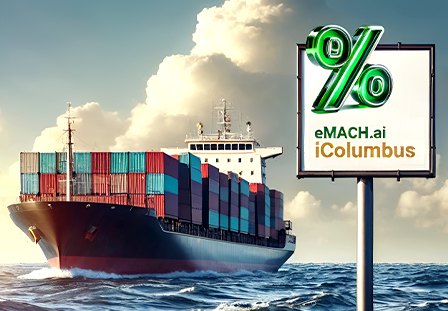- What we do
-
-
-
-
"Intellect’s continued dominance at the IBSi Sales League Table underscores its pioneering role in the fintech industry. Their commitment to innovation, exemplified by the groundbreaking eMACH.ai platform, continues to set a high benchmark in Retail Core Banking, Transaction Banking, and Lending. Intellect’s solutions are not only reshaping the present landscape but are also poised to lead the evolution of financial services globally, driving unprecedented advancements and customer-centric solutions."

Robin Amlôt
Managing Editor at IBS Intelligence
-
-
-
- Company
-
-
-
-
"Intellect’s continued dominance at the IBSi Sales League Table underscores its pioneering role in the fintech industry. Their commitment to innovation, exemplified by the groundbreaking eMACH.ai platform, continues to set a high benchmark in Retail Core Banking, Transaction Banking, and Lending. Intellect’s solutions are not only reshaping the present landscape but are also poised to lead the evolution of financial services globally, driving unprecedented advancements and customer-centric solutions."

Robin Amlôt
Managing Editor at IBS Intelligence
-
-
-
- Knowledge
-
- Our Events
- Contact Us
Africa Roundtable Event
Learn More News FlashiGTB Pulse Newsletter May 2025
Learn More News FlashHighlights of iGTB at EBAday 2025
Learn More News FlashEnhancing Corporate Payment Efficiency with SWIFT GPI Tracker powered by eMACH.ai
Learn More News FlashEmpower Digital Payments: KPI-Driven Payments with Self-Service Intelligence
Read More News FlashUnlocking Africa’s Trade Finance Potential: Driving Growth Through Digital Innovation
Read More


How to select the Best Corporate Payment system for Your Bank
Tapan is a banking technology and domain expert, who now leads the payments product management function for iGTB. He has over 2 decades of experience in banking technology, having worked at Oracle OFSS (i-flex), Wipro, MindTree and Deutsche Software. He has worked in roles that range from development, design, consultancy to strategy and operational roles including managing large teams, top line targets and bottom-line responsibilities. He has implemented banking technology in multiple banks and consulted with CTOs and CIOs at banks on technology driven business and operational efficiency improvement.
Introduction:
The payments sector is poised for tremendous growth and is expected to grow at a compound annual growth rate of 9% over the next five years, according to McKinsey & Company. This growth will be driven by fees, foreign exchange, and account-related liquidity. To capture this wallet share, banks need to select market-leading, best-in-class payment systems. Here are three factors to consider when selecting a payment system for your bank.
- Scalability
- Flexibility
- Interoperability
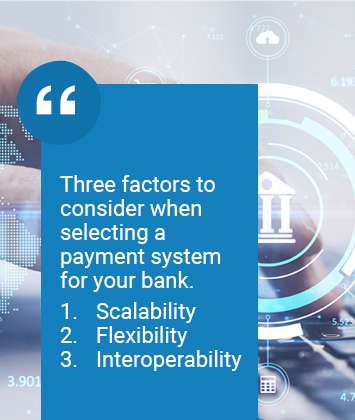

Scalability
As your bank grows, so too will the volume and complexity of payments. It is important to select a payment system that can scale to meet the needs of your bank as it grows. Look for a system that can handle an increasing number of transactions with ease and has the ability to expand to new geographies as needed. Let me share a recent example that me and my team were involved. The payment landscape witnessed an extreme transformation during December of last year, wherein the UK’s large bank experienced a significant surge in volumes. Without warning, corporate clients increased their payments files from hundreds to tens-of-thousands. This incredible shift of payment volumes – from practically non-existent to millions within short two weeks exemplifies just how swiftly corporate clients are able to adjust their payments, based on promotions and other factors. Therefore it’s essential for banks’ payment hubs infrastructure to be flexible and capable enough when dealing with such drastic changes in volume patterns.
Flexibility
No two banks are alike, so it is important to find a payment system that is flexible enough to meet the unique needs of your bank. The system should be able to accommodate your bank’s specific business models, products, and services. It should also be able to integrate with your existing systems and processes. Let’s understand this again with a real-time scenario. As an example of how financial institutions can survive in times of political upheaval, the Ukraine conflict presented a unique opportunity where banks had to be mindful and employ sophisticated payment hubs that monitored both currency and customer origin. Such careful vetting provided for proactive red-flagging when payments required manual action based on country, currency, beneficiary or ordering customer or intermediary/correspondents bank locations within Russia.
Interoperability
In today’s increasingly connected world, it is important for banks to be able to seamlessly communicate and exchange data with one another. Look for a payment system that is built on open standards and has the ability to connect with other systems using APIs. This will enable your bank to easily exchange data with other banks and financial institutions, which is essential for meeting the needs of your customers.
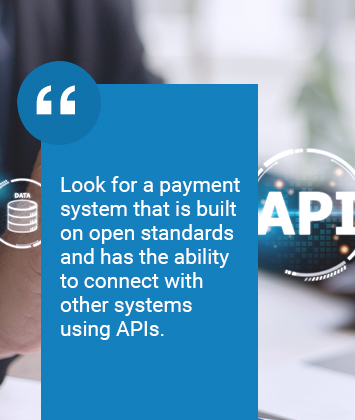
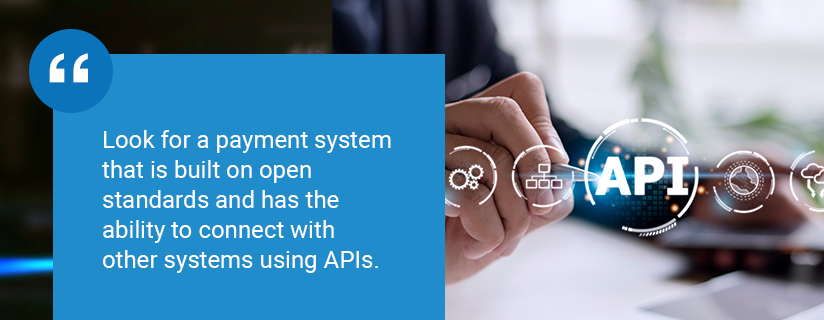
Inter-operability is also crucial because then banks can leverage “best of breed” third parties for payments fraud, fees, AML, sanctions, FX etc and also connect into fintech providers who may for instance provide a cheaper and faster way to send a payment to some country where a bank does not have a correspondent. This interoperability can also extend to core payments processing and systems based on a MACH architecture can actually allow a bank to have independent microservices for payments enrichment, validation, repair, reference data look up etc and this means that banks modernizing their payments landscape need not throw away all their investment.
Modernise your Payments infrastructure with iGTB Payments
The top six reasons Banks need a modern payment solution that is built on microservices, ISO 20022, and can scale elastically are: 1. A ground up Microservices (MACH) architecture ensures that your payment solution can keep pace with the growth of your business. 2. An extended ISO20022 data model provides you with rich data and analytics so that you can make informed decisions about your payments. 3. The ability to scale elastically means that your payment solution can handle high volumes of retail instant payments as well as month end high volumes of large corporate payment files. 4. Supporting value added use cases such as Open Banking, AP Automation, AR Automation, Embedded Payments, and integration with Wallets allows you to take advantage of new technologies as they emerge. 5. Providing rich dashboards and analytics for Payments product Managers, CXO's and COO's gives them the insights they need to better manage and mine payments data. 6. Using AI and ML to reduce payments fraud and enhance payments STP provides you with the peace of mind knowing that your payments are in good hands.
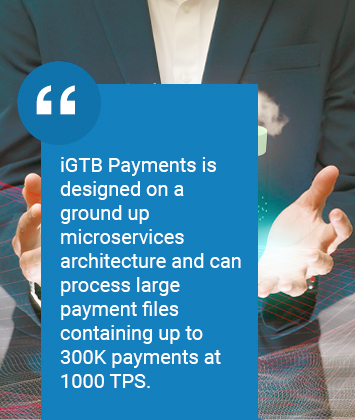
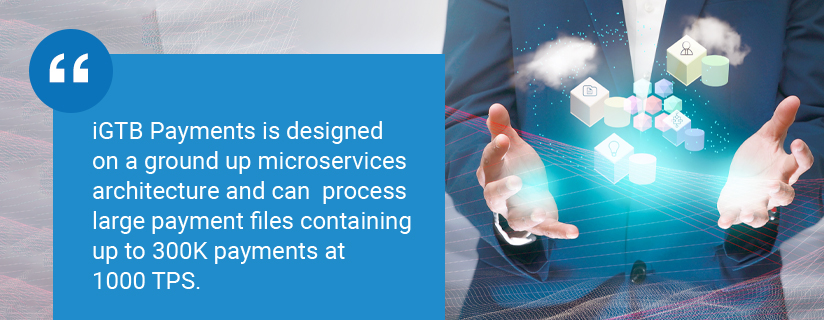
Conclusion:
iGTB Payments is designed on a ground up microservices architecture and can process large payment files containing up to 300K payments at 1000 TPS. Such lightning fast response times are enabled via techniques such as innovative in-memory caching, distributed database technology, multi-pod-processing and priority processing. Additionally payment systems need to have near zero RPO and intellect payments can enable this via multi-az deployment or multi-cloud deployment with the highest levels of availability to ensure complete compliance with Service Level Agreements (SLAs). To stay ahead of the curve, our solution is also equipped with Machine Learning & AI capabilities for optimal Payment Routing - as well as adapters that enable DLT based routing when needed. With Intellect iGTB Payments your bank gets access to a world of real time payment processing capability. We provide 15+ regional instant payments, spanning from Interac in Canada and Sepa Instant in Europe to PIX in Brazil and PromptPay in Thailand. Aite Novarica, a renowned analyst in the banking industry, recently rated our solution as Best in Class and placed it at the top of its list among 15 vendors worldwide. Get all the details on this impressive recognition by reading their full report today!
Click here for details https://www.igtb.com/aite-payments-matrix-report
Tapan is a banking technology and domain expert, who now leads the payments product management function for iGTB. He has over 2 decades of experience in banking technology, having worked at Oracle OFSS (i-flex), Wipro, MindTree and Deutsche Software. He has worked in roles that range from development, design, consultancy to strategy and operational roles including managing large teams, top line targets and bottom-line responsibilities. He has implemented banking technology in multiple banks and consulted with CTOs and CIOs at banks on technology driven business and operational efficiency improvement.


























